Bakkwa 肉乾 or ròu qián (pronounced as rou gan) or Chinese dried meat is ohhh so lip-smacking good. 👍😋🤤❤️ Once you tried it you will love it for life! This smoky, salty and sweet dried jerky meat is usually made from pork because Chinese loves pork! There are also bakkwa made from chicken, beef and yup, turkey and ostrich. Bakkwa is thin and square in shape but in recent years you can also find bakkwa in a thin round shape symbolizing coin aka money and then there’s also bacon bakkwa. Bakkwa is available all year round but very popular during Chinese New Year (CNY) and there are usually long queues outside those famous bakkwa shops a few weeks before CNY.
I remember being basked in the wonderful bakkwa smokes whenever we pass by bakkwa shops at Chinatown aka Petaling Street, Kuala Lumpur during CNY preparation years back. Our clothes would smell like bakkwa long after! These shops would charcoal grill the bakkwa just outside their shops and direct the smoke with a few fans towards the main road. In a way, yes it’s hazardous but it’s a wonderful marketing tactic to draw potential customers (like me) into their shops with their addictive and fragrant bakkwa aromas. You can’t find this experience any more at Petaling Street.
I wanted to make bakkwa for a while now because I found out we can actually make bakkwa at home. Besides, the prices of bakkwa have been steadily rising year after year. In another word, it’s expensive yo! So, I finally made bakkwa… woohoo BUT buttttttt I don’t have soy sauce on hand, one of the main ingredients to make bakkwa. I used shoyu koji 醤油糀 instead and thus 🤩🌟 shoyu koji bakkwa 🌟🤩 was born.

Shoyu koji bakkwa 醤油糀肉乾 is a fusion bakkwa where China meets Japan. The enzymes in shoyu koji tenderize the meat and as well as adding more oomph!
p/s: Noticed the uneven thickness? I’ll talk about it more below.
Let’s make this fusion bakkwa!
First things first, this bakkwa recipe uses a modern technique whereby an oven is used to cook/bake the meat. Hence, you can make bakkwa in just a few hours. Traditionally, bakkwa is a form of food preservation and it’s made by air-drying the marinated meat for a few days.
If you don’t have shoyu koji but still want to make bakkwa, you can easily adjust the soy sauce amount (put a little more as shoyu koji is saltier than regular soy sauce).
.jpg)
Place minced pork (mine here was minced from pork shoulder and its fat) in a large bowl. I’ve no idea of the fat % but it’s quite fatty from the look of it and it’s quite pasty (you can request your butcher to grind the meat finer).

Add marinade ingredients: shoyu koji, fish sauce, organic cane sugar, five spice powder, Shaoxing wine, honey and black+white pepper to the bowl.

Combine everything and mix thoroughly until it becomes a wet paste. As this pork mixture contains shoyu koji, you don’t want to rest it for too long as the enzymes will over-tenderize the meat. Read my shio koji and shoyu koji posts to get a better grasp on what koji can do to your food: heavenly and more! Hence, an hour is enough for resting in the fridge. If you’re using soy sauce, an hour or longer or overnight is good.
While waiting, get ready two square baking pans with raised sides with the dimensions: 33cm x 33cm (13″ x 13″). Yes, this recipe makes two pans. If you only have one pan, it’s alright too. It’ll just take a little longer. Also, cut two pieces of baking paper that will fit into the baking pans.
An hour later, preheat the oven to 180oC (no fan/conventional) or 160oC (fan/convection) and set it to top and bottom heat. Take out the pork mixture from the fridge.
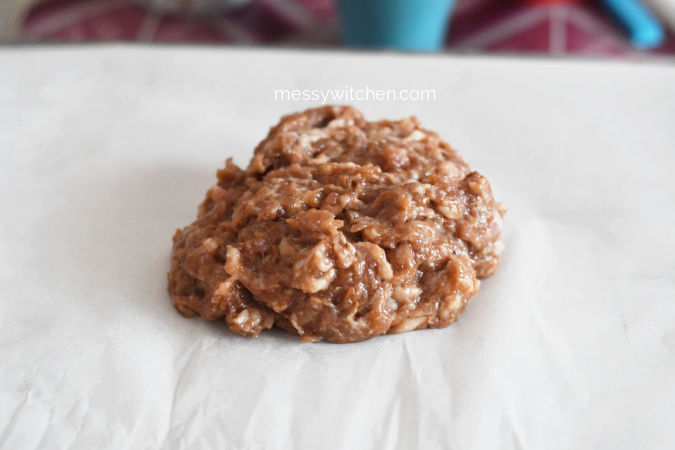
Place a piece of baking paper on the table and scoop half of the pork mixture on the middle of the paper. For me, I rolled the meat mixture on the baking paper on the flipped baking pan.
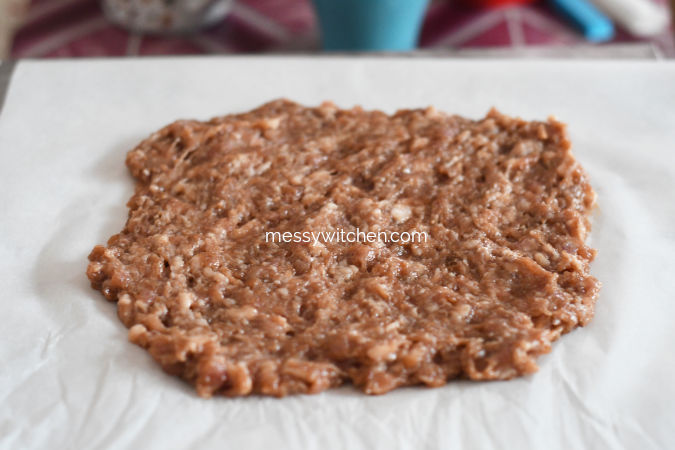
Use the back of a spoon to spread and shape the pork mixture into a square so that when it’s rolled, it becomes nearly square shape. Of course, I know that you can control and shape the square shape by the way you roll it.

Place a cling film (around the size of the baking paper) on top of the pork mixture. Then, roll the pork mixture to a thickness of 2mm with a rolling pin.
Confession: If you’ve been following me for a while, you’ll know that I mentioned in one of the posts that I no longer use cling film. And, here I am using one. LOL And at the end of last year, I used another one… for my miso. Oops! When I make bakkwa again, I will try using baking paper instead. Let’s see if it’ll work.

Very important is to make sure that the thickness of the rolled meat is even throughout. Due to my inexperience, the resultant shoyu koji bakkwa has an uneven thickness whereby the center part of the rolled meat is thicker while the rest is thinner.
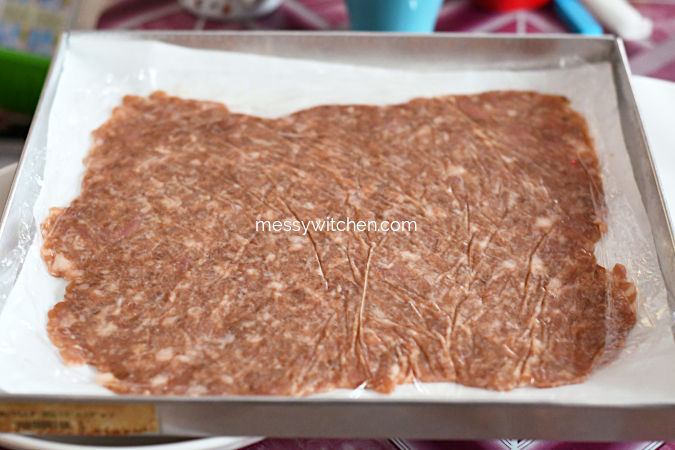
Transfer the rolled pork mixture together with the baking paper into the baking pan. Remove the cling film and reuse it when you prepare the second pan.

After removing the cling film, you can see creases on the pork mixture surface made by the cling film. It doesn’t matter once it’s cooked. you’ll see below.
Put the baking pan on the middle rack of the preheated oven and cook/bake for 15 minutes. Remember to rotate the pan at halfway mark so that it’s evenly cooked. While the first baking pan is in the oven, prepare the last half of the pork mixture in another baking pan. Start by placing it in the middle of a baking paper, shape it into a square with a spoon, cover with a cling film and roll it, etc, etc. If you only have one pan? Then, wait.
Once it’s done baking, there will be meat juice on the pan. Use a spoon to scoop out 2 tablespoons of meat juice which will be used for the glaze. Gather meat juice from the 2nd pan if the first one is not enough to yield 2 tablespoons. If you have more meat juice? Keep it for use in cooking. It’ll be divine.

This is the baked pork mixture from baking pan #1. As mentioned above, you almost don’t see the creases anymore, only bumpy surfaces which are natural.

Close-up of the cooked pork mixture aka undressed shoyu koji bakkwa from baking pan #1.
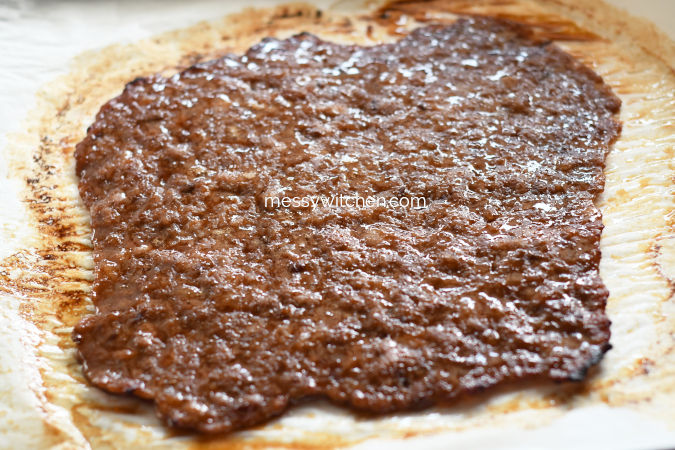
This is the baked pork mixture from baking pan #2.

Close-up of the cooked pork mixture aka undressed shoyu koji bakkwa from baking pan #2. I feel like wanna grab this big piece straight away and eat it. It’s a full meal then. 😀
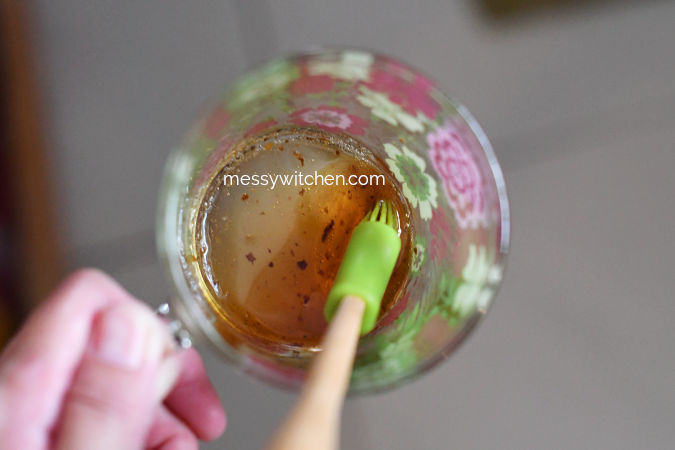
Make the bakkwa glaze by mixing the gathered meat juice with honey, 2 tablespoons each.

Once the cooked pork mixture is cooled to the touch, divide it into 6-9 portions or your preferred size. I love to snack on a large piece of bakkwa hence I portioned mine into 6 pieces, totalling 12 pieces for this recipe. You can use a kitchen scissors, a knife or a pizza cutter to cut it. I used a pair of scissors.

Shoyu koji bakkwa are ready to be grilled. Oh la la!
Heat up your grill ka chang (equipment). You can use the grill function of the oven (200oC-230oC on the top rack), a charcoal/BBQ pit or cast iron grill.

Apply a generous amount of glaze on one side of the undressed bakkwas.

Using a cast iron grill, place the glazed side face down on the grill. The same applies to charcoal/BBQ pit as the heat comes from the bottom. If you’re using the oven to grill, the glazed side must face up as the heat comes from the top side.
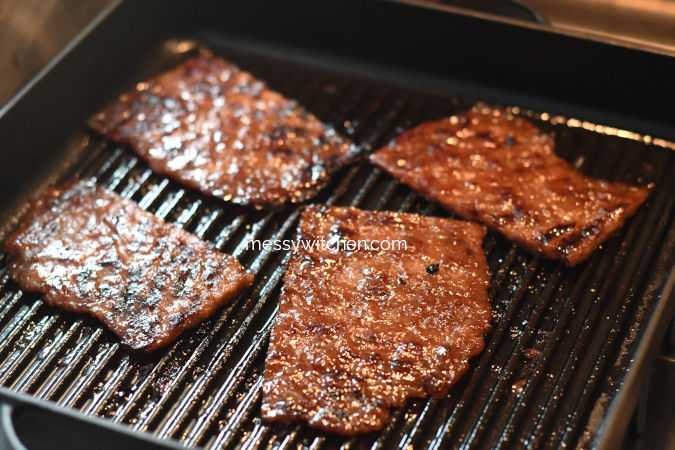
The side is done when there are some grilled marks on the surface and edges. Next, apply the glaze generously to the other side and grill it.
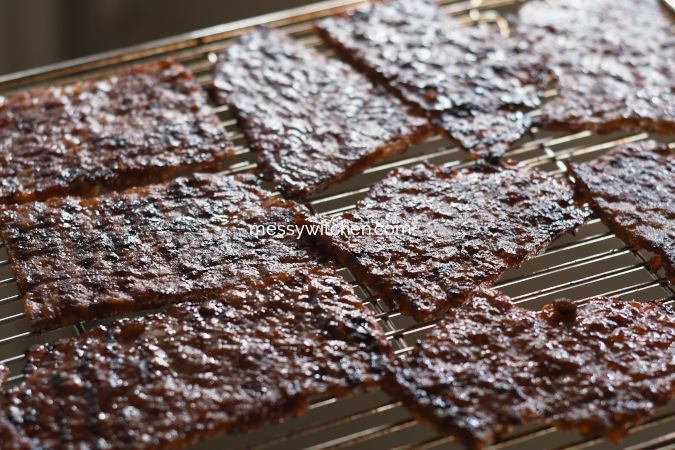
My preciousssss!
Transfer the shoyu koji bakkwas to a cooling rack to cool them before storing them in a container. You can store it at room temperature if you can finish it up in a few days. Otherwise, the fridge or freezer is the best place. Bring the shoyu koji bakkwa to room temperature before devouring it.

Tell ya a secret. Making bakkwa is a breeze. Really! The hardest part and most time-consuming part is washing the cast iron grill!!! 😛

I dropped this piece right after photographing it. Nope, I did not eat it as it was at the backdoor areas. But I did consider it for a few seconds. LOL

The cross-section of a piece of shoyu koji bakkwa. I’m sure you saw how one end is thinner while the other end is thicker. Yep. Nevertheless, it was freaking delish. But does it taste like regular bakkwa? It’s difficult to compare as each brand has its own unique flavor. Shoyu koji bakkwa also has its own unique flavor and it definitely reminds me that I’m eating bakkwa. Haha

Shoyu koji bakkwa 醤油糀肉乾 is rich in flavor and umamilicious! It has a balanced salty and sweet but lean on the sweet side a lil’ (thanks to the koji enzymes). Shoyu koji bakkwa is tender yet still have some bite to it.
Compared to this one famous brand’s minced pork bakkwa which I sometimes had a very difficult time chewing because they’re so tough (it’s like my teeth are having a heavy workout), shoyu koji bakkwa is totally different. It’s easy to eat and very addictive plus the tantalizing smoky charred aromas can be detected a few centimetres away. It’s like it’s saying “Come to me, I know you want to eat me!”
Two things I’ll improve/change in the next round are to make sure the bakkwa is rolled evenly and to use another brand’s five spice powder. I used the famous Pok Oy Thong’s five spice powder. Next round, I’ll try Pok Siew Thong’s as I find this one suits my tastebuds the best be it in sweet or savory dishes.
So, give this shoyu koji bakkwa recipe a try. You won’t regret it. Have something different this CNY.
Psst, let me tell you another secret… the shoyu koji bakkwa tastes even better a day after. 👍👍👍
Shoyu Koji Bakkwa 醤油糀肉乾
Adapted from Dapur 2020
Yields 2 pans
500g minced meat (I requested the butcher to mince pork shoulder with its own fat; not sure how much % of fat but quite fatty)
Marinade:
1.5 tablespoons shoyu koji (if using soy sauce, add a little bit more than 1.5 tablespoons)
1 tablespoon fish sauce
50g organic cane sugar
1 teaspoon five spice powder
2 tablespoons Shaoxing wine
2 tablespoons honey
a few dashes of black+white pepper
Glaze:
2 tablespoons meat juice (collect after baking)
2 tablespoons honey
2 x 33cm x 33cm (13″ x 13″) square baking pan with raised sides
Method:
1. Place minced pork and the marinade ingredients in a large bowl. Mix well until it becomes a paste. You can request your butcher to grind the pork finer. Rest the pork mixture in the fridge for an hour. You don’t want to rest the pork mixture using shoyu koji too long or it’ll be extra tender. If using soy sauce, you can rest for at least an hour or longer or even overnight.
2. An hour later: Preheat the oven to 180oC (no fan/conventional) or 160oC (fan/convection). Use top and bottom heat AND remove the pork mixture from the fridge.
3. Lay a piece of baking paper on the kitchen table and place half of the pork mixture at the center of the baking paper.
4. Then, use the back of a spoon to spread the pork mixture. Best to shape it into a square so that when you roll it, it becomes more or less square.
5. Place a cling film about the size of the baking paper on top of the pork mixture. Use a rolling pin to roll the pork mixture to about 2mm in thickness evenly. Due to my inexperience in rolling, the baked meat has a thicker center and thinner outer areas.
6. Next, carefully move the rolled pork mixture with the baking paper to the baking pan. Peel off the cling film and keep it to use for the last half. The rolled pork mixture may have crumpled patterns due to the cling film. It doesn’t matter once it’s cooked.
7. Bake on the middle rack for 15 minutes in the preheated oven. Rotate the pan halfway to ensure even cooking. When the cooked meat is out of the oven, use a spoon to gather 2 tablespoons of the meat juice (for the glaze). If it’s not enough, you can collect the juice from the next batch. Cool the cooked meat a bit so that it’s easier to handle in step no. 9.
8. While baking, repeat steps 3 to 7 for the other half of the pork mixture. If you don’t have 2 pans, then wait till the first one is done.
9. Continue from step no. 7, use kitchen scissors (easier and less washing up), kitchen knife or pizza cutter and cut the cooked meat into your preferred portions (about 6-9 portions or to your liking).
10. To make the glaze, simply mix the meat juice and honey.
11. Now comes the last part: Grilling. You have several options. You can use the grill function of the oven (200oC-230oC on the top rack), a charcoal/BBQ pit or a cast iron grill. Brush one side of the undressed bakkwa with the glaze (be generous) and grill it until there are some grilled marks on the surface and edges. Once one side is done, glaze (be generous again) the other side and grill again.
For oven: grill with the glazed meat face up coz the heat comes from the top;
For charcoal/BBQ/cast iron: grill with the glazed meat face down coz the heat comes from the bottom.
12. Cool the shoyu koji bakkwas on a cooling rack. Store at room temperature if you plan to finish it in a couple of days. Otherwise, store it in a container in the fridge or freezer. Bring the shoyu koji bakkwa to room temperature before enjoying it.
Happy bakkwa-ing!




No Comments